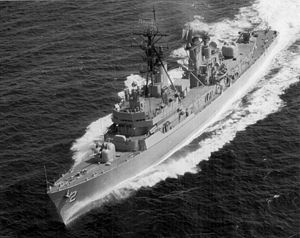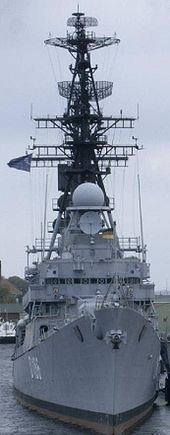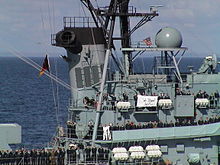- Charles F. Adams class destroyer
-

USS Charles F. Adams (DDG-2)Class overview Name: Charles F. Adams class destroyer Builders: Bath Iron Works
New York Shipbuilding Corporation
Defoe Shipbuilding Company
Todd Pacific Shipyards, Seattle, Washington
Avondale Marine
Puget Sound Bridge and Dredging CompanyOperators:  United States Navy
United States Navy
 Hellenic Navy
Hellenic NavyPreceded by: Farragut-class destroyer Succeeded by: Spruance-class destroyer Subclasses:  Royal Australian Navy: Perth-class
Royal Australian Navy: Perth-class
 German Navy: Lütjens-class
German Navy: Lütjens-classCompleted: 23 Retired: 23 Preserved: 1 General characteristics Class and type: Guided missile destroyer Displacement: 3,277 tons standard, 4,526 full load Length: 437 ft (133 m) Beam: 47 ft (14 m) Draught: 15 ft (4.6 m) Propulsion: 2 × steam turbines providing 70,000 shp (52 MW); 2 shafts
4 x 1,275 psi (8,790 kPa) boilersSpeed: 33 knots (61 km/h) Range: 4,500 nautical miles (8,300 km) at 20 knots (37 km/h) Complement: 310-333 Sensors and
processing systems:1 AN/SPS-10 surface search RADAR[1]
1 AN/SPS-37 air search RADAR[1]
1 AN/SPS-39 3D air search RADAR[1]
2 AN/SPG-51 Tartar fire control RADAR[1][2]
1 AN/SPG-53 gun fire control RADAR[1][3]
AN/SQS-23 SONAR[1][4]Armament: 1 Mark 11 launcher (DDG2-14) or Mark 13 single arm launcher (DDG-15-24) for Tartar SAM system or later the Standard SM-1 and Harpoon antiship missile
2x Mark 42 5in(127mm)/54
1x ASROC Launcher
6x 12.8in(324mm) ASW Torpedo Tubes (2xMark 32 Surface Vessel Torpedo Tubes)The Charles F. Adams class is a ship class of 29 guided missile destroyers built between 1958 and 1967. Twenty three ships were built for the United States Navy, 3 for the Royal Australian Navy, and 3 for the West German Bundesmarine. The ships were based on the existing Forrest Sherman class, but were the first destroyers designed to serve as missile destroyers. They added 19 feet (5.8 m) of length to the center of the Forrest Sherman design to accommodate the ASROC launcher and changed the boilers from 600 psi (4,100 kPa) to 1,275 psi (8,790 kPa). Both of these changes ultimately caused significant maintenance problems for all ships in the class. The Charles F. Adams-class destroyers were the last steam-powered destroyers built for the U.S. Navy; beginning with the follow-on Spruance-class destroyers, all succeeding destroyer classes have been powered by gas turbines. The destroyers of this class served in the Cuban blockade of 1962 and the Vietnam War.
Although designed with cutting edge technology for the 1950s, by the mid 1970s it was clear to the Navy that the Charles F. Adams class was ill-prepared to deal with modern air and missile threats. To reduce this vulnerability, the Navy initiated the New Threat Upgrade (NTU) program, which consisted of a number of sensor, weapons and communications upgrades, intended to extend the service life of the ships. Under NTU the Adams class would receive improved electronic warfare capability through the installation of the AN/SLQ-32(V)2 EW Suite. The upgraded combat system would include the MK86 Gun Fire Control System with AN/SPQ-9 radar, Hughes AN/SPS-52C 3D radar, AN/SPG-51C (Digital) Fire Control Radars, and Naval Tactical Data System (NTDS). The ships would also have the ability to launch RGM-84 Harpoon anti-ship missiles, to be housed in the MK-11 Tartar missile launcher.
During the 1980s, the Reagan Administration chose to accelerate production of the Ticonderoga-class guided missile cruisers and build the Arleigh Burke-class guided missile destroyers as a replacement for the Adams class. The result of this was that only three ships, Tattnall, Goldsborough, and Benjamin Stoddert received the full upgrade. Other ships, of the class, such as Charles F. Adams, received only partial upgrades which included the AN/SLQ-32 and Harpoon Missile upgrades intended to extend their service lives until the Burke class could reach operational capability.
The United States Navy decommissioned its last Charles F. Adams destroyer, the Goldsborough, on April 29, 1993. The Australian and German navies had also decommissioned their last ships of this class by 2003. Four ships of this class were transferred to the Hellenic Navy in 1992, but have since been decommissioned.
The Charles F. Adams has been placed on inactive hold status and there are attempts by private groups to have it preserved as a museum ship. Mölders (D186) was made into a museum ship, but all of the other destroyers in the class have been sunk as targets, sunk for dive wrecks or sold for scrap.
Contents
Ships in class
Ship Name Hull No. Commission–
DecommissionFate Notes Charles F. Adams DDG-2 1960–1990 Museum hold [5] John King DDG-3 1961–1990 Scrapped [6] Lawrence DDG-4 1962–1990 Scrapped [7] Claude V. Ricketts DDG-5 1962–1989 Scrapped [8] Barney DDG-6 1962–1990 Scrapped [9] Henry B. Wilson DDG-7 1960–1989 Sinkex [10] Lynde McCormick DDG-8 1961–1991 Sinkex [1] Towers DDG-9 1961–1990 Sinkex [2] Sampson DDG-10 1961–1991 Scrapped [3] Sellers DDG-11 1961–1989 Scrapped [4] Robison DDG-12 1961–1991 Scrapped [5] Hoel DDG-13 1962–1990 Converted to power barge, then scrapped [6] Buchanan DDG-14 1962–1991 Sinkex [7] Berkeley DDG-15 1962–1992 Sold to Greece as Themistocles (D-221), scrapped later [8] Joseph Strauss DDG-16 1963–1990 Sold to Greece as Formion (D-220), scrapped later [9] Conyngham DDG-17 1963–1990 Scrapped [10] Semmes DDG-18 1962–1991 Sold to Greece as Kimon (D-218), scrapped later [11] Tattnall DDG-19 1963–1991 Scrapped [12] Goldsborough DDG-20 1963–1993 Sold to Australia as a parts hulk, scrapped later [13] Cochrane DDG-21 1964–1990 Scrapped [14] Benjamin Stoddert DDG-22 1964–1991 Sank while under tow enroute for scrapping [15] Richard E. Byrd DDG-23 1964–1990 Sold to Greece for parts, sunk as target later [16] Waddell DDG-24 1964–1992 Sold to Greece as Nearchos (D-219), sunk as target later [17] - edit] Lütjens class
Main article: Lütjens class destroyer
The Lütjens class destroyer was a modification of the Charles F. Adams class for the Bundesmarine (the Navy of West Germany). It differed from the Adams class in the layout of the crew accommodations, the location of the bow sonar, a second large aerial mast and different funnels.
Perth class
Main article: Perth class destroyerThe Royal Australian Navy had three Charles F. Adams class units constructed to their own specifications (these ships were designated the Perth class). Although broadly similar to the US Navy's vessels, the Australian ships were fitted with the Ikara system instead of the ASROC that was fitted to the American units. The three ships were:
See also
Notes
- ^ a b c d e f Blackman, Raymond V. B. Jane's Fighting Ships (1970/71) p.437
- ^ Polmar, Norman "The U.S. Navy: Shipboard Radars" United States Naval Institute Proceedings December 1978 p.144
- ^ Polmar, Norman "The U.S. Navy: Shipboard Radars" United States Naval Institute Proceedings December 1978 p.145
- ^ Polmar, Norman "The U.S. Navy: Sonars, Part 1" United States Naval Institute Proceedings July 1981 p.119
- ^ http://www.nvr.navy.mil/nvrships/details/DDG2.htm
- ^ http://www.nvr.navy.mil/nvrships/details/DDG3.htm
- ^ http://www.nvr.navy.mil/nvrships/details/DDG4.htm
- ^ http://www.nvr.navy.mil/nvrships/details/DDG5.htm
- ^ http://www.nvr.navy.mil/nvrships/details/DDG6.htm
- ^ http://www.nvr.navy.mil/nvrships/details/DDG7.htm
References
External links
- D-186 FGS Mölders, Deutsches Marine Museum, Wilhelmshaven Germany
- DDG-38 HMAS Perth, Artificial Dive Reef, Albany Australia
- DDG-2 USS Charles F. Adams, Jacksonville Historic Naval Ship Association, Jacksonville Florida
- Adams Class Veterans Association
- Charles F. Adams-class guided missile destroyers at Destroyer History Foundation
Charles F. Adams-class destroyer United States Navy
United States NavyCharles F. Adams · John King · Lawrence · Biddle ⁄ Claude V. Rickets · Barney · Henry B. Wilson · Lynde McCormick · Towers · Sampson · Sellers · Robison · Hoel · Buchanan · Berkeley · Joseph Strauss · Conyngham · Semmes · Tattnall · Goldsborough · Cochrane · Benjamin Stoddert · Richard E. Byrd · Waddell
 German Navy
German Navy
Lütjens class Royal Australian Navy
Royal Australian Navy
Perth class Hellenic Navy
Hellenic Navy
List of destroyers of the United States Navy · List of destroyer classes of the United States Navy
Categories:- Charles F. Adams class destroyers
- Destroyer classes
- edit] Lütjens class
Wikimedia Foundation. 2010.


